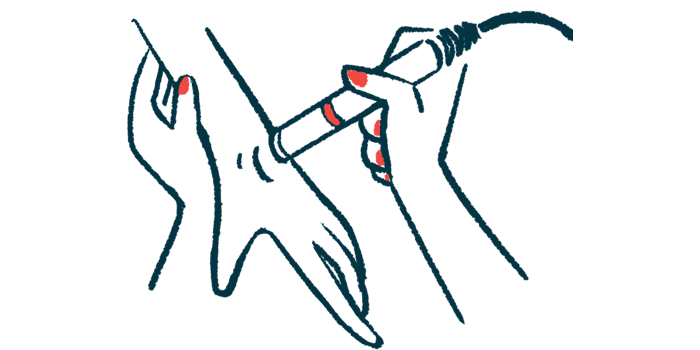Nerve ultrasound of arms may help monitor disease severity in FA
High-resolution scans revealed changes to nerves in armpits, arms

The use of high-resolution ultrasound in people with Friedreich’s ataxia revealed nerve changes in the armpits and arms that correlated with disease severity in a small study by researchers in Italy.
These results suggest that such ultrasounds of the nerves running through the axilla region — the armpits — of patients, and through the arms, could be used to help monitor FA severity.
According to the researchers, changes in nerve ultrasound may be “a potential biomarker of disease severity” in FA.
The study, “Nerve Ultrasound in Friedreich’s Ataxia: enlarged nerves as a Biomarker of disease severity,” was published in the journal Clinical Neurophysiology.
Seeking biomarkers of disease severity, treatment response
Friedreich’s ataxia is caused by a shortage of frataxin, a protein linked to energy production in cells. Without frataxin, nerve cells become damaged over time, particularly in areas of the spinal cord involved in movement control and coordination.
Research has been focusing on ways to measure how severe the disease is and whether treatment is working. Nerve conduction studies are used to see how fast electrical signals move through a nerve and can tell whether signaling is slowed or absent.
However such tests fail to measure disease severity or a patient’s response to treatment.
Now, a team of researchers from Rome turned to high-resolution ultrasound, which uses high-energy sound waves to form pictures of tissues on a computer screen.
“Nerve ultrasound can provide useful information where [a] nerve conduction study is no longer informative,” the team wrote.
Their study included 10 adults with Friedreich’s ataxia, with a median disease duration of 21 years. The eight women and two men had a median age of 40. All had sensory axonal neuropathy, or sensory loss due to damage to the nerves outside the brain and spinal cord.
In a nerve conduction study, nine were found to have absent sensory nerve action potentials — which are electrical signals propagated along nerve fibers. One had a severe reduction of sensory nerve action potentials.
Nerve ultrasound shows significantly enlarged nerves in FA patients
The researchers compared the findings from the patients with the results of ultrasound scans from 20 healthy volunteers, who served as controls.
The individuals with Friedreich’s ataxia were found to have significantly enlarged median and ulnar nerves in the armpits and arms. Median and ulnar nerves control the movement of a person’s forearms and hands.
“Nerve enlargement, in combination with severe sensory axonal loss at [the] nerve conduction study, is a peculiar finding,” the researchers wrote, noting that nerve swelling is not often studied in FA.
“This emphasizes the significance of our findings in the context of Friedreich’s ataxia,” they added.
[These findings highlight] the potential of high-resolution nerve ultrasound as a sensitive biomarker in Friedreich’s ataxia.
The more widely the nerves were affected, the more severe the disease, the researcher found. This was assessed by higher scores on the Scale for the Assessment and Rating of Ataxia, the Friedreich’s Ataxia Rating Scale and its modified version, and the Inflammatory Neuropathy Cause and Treatment Disability Score.
More changes on nerve ultrasound also were linked to more disability and less independence in the ability to carry out activities of daily living. Such muscle weakness in the upper limbs can make simple tasks in everyday life challenging.
While the study included a small sample, it showed a “consistent correlation” between nerve enlargement on the ultrasound scans and clinical measures of disease severity.
These findings highlight “the potential of high-resolution nerve ultrasound as a sensitive biomarker in Friedreich’s ataxia,” the team wrote.








